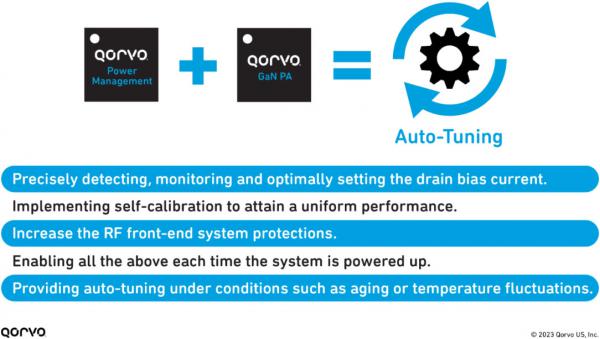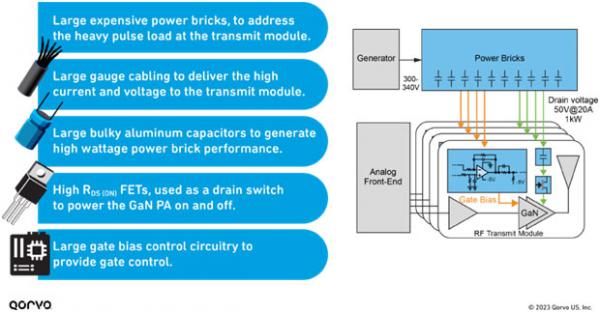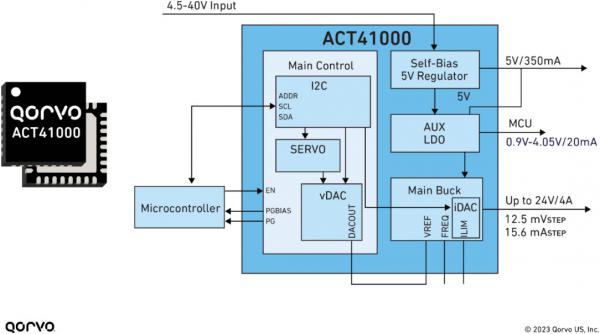Power supply solution for GaN power amplifiers
Time:2023-12-05
Views:502
The high-power final stage power amplifier of RF front-end has been replaced by GaN power amplifier. Gate negative pressure bias sets it apart from other technologies in design, and sometimes poses certain challenges in design; But its performance is unique in many applications. Read this article to understand how Qorvo‘s power management solution eliminates gate bias differences in GaN.


Nowadays, electronic engineers understand that GaN technology requires gate negative voltage operation. This was once considered negative - here "negative" and "negative" are not puns - but today, some techniques make this gate negative pressure operation negligible. Today, we have power management integrated circuit (PMIC) devices that can easily and reliably power on and off these GaN PAs, as well as other advantages brought by PMICs. We will provide a detailed introduction below.
In this blog article, we will explain how PMIC is used to design and control RF GaN PA technology in radar, wireless infrastructure, satellite communication, and other applications. We will also explore how PMIC can help optimize RF front-end (RFFE) design for optimal performance.
Exploring the System Challenges of RFFE Power Management in Depth
In previous blog posts, we discussed the obstacles encountered when using GaN power amplification technology for design in RFFE. Here is a review of the relevant content:

From the perspective of electricity supply, there are other obstacles, such as:

In fact, adopting PMIC can completely eliminate the above-mentioned obstacles.
Gain a deeper understanding of power rails
In many RF amplifier systems, the power rail of RFFE is likely to be a switch mode power supply. These switching power supplies have high voltage swing and high slope, which increases the possibility of noise. In addition, it will also generate a small amount of power modulation noise, such as the measured power modulation ratio (PSMR). This PSMR is a measurement of defects (ripple and noise) modulated onto RF transmission carriers. Non isolated RF load point regulators (RF PoL in PMICs) can be used to reduce or eliminate this noise. Implementing RF PoL/PMIC can bring the high-precision voltage rail, fast dynamic response load, and low noise required for optimal operation of RFFE applications.
For RF power amplifier applications, it is important to have a pure transmitter signal and avoid power interference to avoid spikes (radiation from other lines) around the carrier frequency. This is precisely the advantage of RF PoL; It can generate high output voltage, which helps optimize the efficiency of power amplifiers, control the rated value of power amplification devices, and build an adjustable control loop to provide a low-noise power supply. As shown in the figure below, with the help of SiC FETs, ACT43950, and ACT43850 power chain devices, a fully functional low-noise power chain can be obtained.


Simplified power supply, PMIC, and RFFE
The above PMIC block diagram is decomposed as follows:
GaN PA PMIC controller
·ACT43750- is a highly integrated drain switch and gate negative pressure regulator that enables ultra fast RF GaN power amplifier drain switching. In addition, it can automatically maintain a constant RF GaN power amplifier gate voltage bias timing instantaneously, and provide dynamic bias calibration - that is, adjustment for temperature fluctuations, current collapse, and device aging.
·Start automatic bias control timing
·Automatically generate gate negative bias voltage
·Automatically calibrate bias point when powered on
·Provide on/off drain switch
When the GaN power amplifier experiences drift due to temperature drift and aging, recalibrate the bias point
Power supply - constant current regulator and step-down RF PoL
·ACT43950- a high-voltage constant current capacitor charging controller, used in conjunction with Qorvo‘s SiC FET, can provide full range programmable output voltage rail and current
·ACT43850- RF PoL buck DC-DC power converter; It uses the output of ACT43950 and reduces it to a good stable voltage optimized for GaN power amplifiers. With its advanced configuration options, the RFFE system can minimize noise and electromagnetic interference (EMI) to achieve maximum performance.
In the previous text, ACT43750 regulates the gate and drain - the drain voltage range is 10 to 55V. It should be noted that if your system design has already implemented voltage rails, ACT43750 can also be used independently. In this case, ACT43750 and switches (GaN or Si) need to be added. The ACT43750 in the system provides a constant rail of 10 to 55V DC for the GaN devices in the RF system (suitable GaN power amplifiers for this voltage range include QPD0005M, QPA0017, and QPA2612. For other products, please visit qorvo. com/products/amplifiers/power amplifiers). However, without adding ACT43950 and ACT43850, your design will require larger power components and wires, as described above.
ACT41000 can be used for low-voltage solutions; Its drain voltage range is 3 to 24V. The previous blog post "Using a Power Management Module to Power on (and Power off) GaN Power Amplifiers" provided an overview of this device; This blog post and related video tutorials (qorvo. com/design hub/videos/using advanced power management to optimize gan pa performance) introduce how to set up and use the device in the system.


ACT41000 PMIC used in RF system design
This device, like the aforementioned PMIC, SiC FET, and GaN power amplifier devices, is suitable for fields such as radar and wireless infrastructure.
epilogue
Today‘s RF systems are becoming smaller and require wider RF bandwidth, higher power, higher operating temperatures, and must be more reliable than previous solutions. This usually means an increase in system complexity; But using Qorvo‘s PMIC in RF GaN applications can make complex power trees easier to manage. PMIC makes control, operation, and performance more precise, reliable, and optimized. The progress of technology has once again amazed us. Now, with the adoption of PMIC, design engineers can better and more easily design, while creating technologically advanced RFFE systems.
To learn more about this topic and get solutions to your latest design challenges, please visit Qorvo Design Hub (qorvo. com/design hub) for rich videos, blog articles, white papers, and tools.
|
Disclaimer: This article is transferred from other platforms and does not represent the views and positions of this site. If there is any infringement or objection, please contact us to delete it. thank you! |











